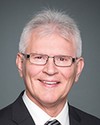Sure.
Mr. Chair, and committee members, thank you. It's a great privilege to join you here today. It's always a privilege to visit this committee and all of the House committees.
I'm Michael Nadler. I am the interim chief executive officer of Parks Canada. The last time we presented with you, Daniel Watson was sitting in that role.
With me today is Sylvain Michaud, Chief Financial Officer at Parks Canada Agency.
As I mentioned, we're really happy to be with you. It's a privilege for us to present to you.
If you don't mind, I would like to give a brief overview of the Supplementary Estimates (A) 2018-2019 for Parks Canada Agency.
With your permission, as you mentioned, I'd like to begin with a short overview of the Parks Canada Agency supplementary estimates (A) for the fiscal year 2018-19. Then, we'd be pleased to receive any questions committee members might have.
The agency's supplementary estimates (A) submission amounts to an increase to the agency's voted appropriations of $45.5 million. This is approximately 3% of Parks Canada's voted authorities to date for the fiscal year. These supplementary estimates would bring the agency's proposed voted authorities to date to $1.69 billion for the current fiscal year.
This funding is requested for six initiatives.
First, there is $21 million to purchase a unique and important property located within the boundary of Bruce Peninsula National Park. The funds originate with budget 2018 for the protecting Canada's nature, parks and wild spaces initiative. This parcel of land will bring the Bruce Peninsula National Park to nearly 90% completion. It's home to 10 species at risk as well as rare ancient cliff-edge ecosystems. The expansion of Bruce Peninsula National Park is one of the priority initiatives of a nature legacy for Canada.
Second, there is $14.8 million, also from budget 2018, to help us conclude an impact and benefit agreement for Nahanni National Park Reserve and advance indigenous collaborative management and reconciliation initiatives at Tallarutiup Imanga, or Lancaster Sound, the marine conservation area in Nunavut. These efforts are also part of a nature legacy for Canada and support the advancement of conservation of natural and cultural heritage while strengthening Parks Canada's collaborations and relationships with indigenous peoples.
Third, there is $7.5 million from budget 2017 to provide a contribution to the Trans Canada Trail, which is a registered non-profit charitable organization dedicated to enhancing and maintaining Canada's Great Trail, a national network of multi-use recreational trails that links 15,000 communities across the country and spans some 24,000 kilometres. Canada's Great Trail is one of the longest recreational trail systems in the world.
Fourth, there is $1.1 million to advance Parks Canada's involvement in negotiations on rights reconciliation agreements with the Mi'kmaq, Maliseet and Peskotomuhkati first nations in the Atlantic region. These negotiations are for renewal of treaty-related measures on fisheries governance and access and to test new treaty-related measures relating to governance and fisheries access. Also being negotiated in these treaty-related measures are stewardship of natural and cultural resources, harvesting and co-operative management in Parks Canada places in the region.
Fifth, there is $673,000 from Treasury Board to provide for surge capacity to increase support services to employees with pay issues at Parks Canada as a result of the implementation of the Phoenix pay system. This includes assistance in informing employees of the support and information available to them.
Sixth, there is $475,000 in the form of a transfer from the Department of Transport to complete three climate risk assessment reports looking at climate change risks to highway infrastructure in Kootenay National Park, the Trans-Canada Highway in Glacier National Park, and the Eastport causeway highway in Terra Nova National Park.
The transportation assets risk assessment program's aim is to improve the understanding of climate risks to federal transportation infrastructure by providing those responsible for the assets with the information upon which investment decisions and asset management plans can be based in the future.
Thank you for your attention. We'll be glad to answer any question you may have.
Many thanks, Mr. Chair and members, for your attention.
Sylvain and I would be pleased to take your questions at this time.





